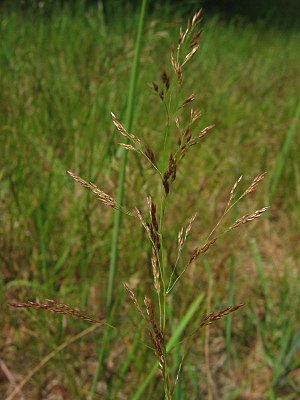Red ostrich grass
| Red ostrich grass | ||||||||||||
|---|---|---|---|---|---|---|---|---|---|---|---|---|

Red ostrich grass ( Agrostis capillaris ) |
||||||||||||
| Systematics | ||||||||||||
|
||||||||||||
| Scientific name | ||||||||||||
| Agrostis capillaris | ||||||||||||
| L. |
The red ostrich grass ( Agrostis capillaris ) (or red ostrich grass called) is a species of the genus ostrich grass ( Agrostis ) within the sweet grass family (Poaceae).
description
The red ostrich grass is a very changeable bluegrass.
Vegetative characteristics
The red ostrich grass is a perennial herbaceous plant and reaches heights of 20 to 60 centimeters. It forms short, underground runners and therefore grows like clumps. The ligule is only up to 1 mm long. Its flat, 2 to 4 mm wide leaves are green in color, grooved on the top and dull on the underside. The leaf blades are bare on all sides. The youngest leaves appear rolled up when cut open.
Generative characteristics
The flowering time is in June and July. There is a loose, paniculate inflorescence . The 2 to 3 mm long spikelets are single-flowered, reddish-violet in color, have no awn, appear compressed at the sides and have more or less clearly keeled husks. In total, each spikelet has two glumes that are longer than the lemma. These are not hairy.
The number of chromosomes is 2n = 28.
ecology
The red ostrich grass is a hemicryptophyte and a clump grass with short underground runners. The vegetative reproduction occurs through runners . It roots up to 50 centimeters deep.
Pollination takes place by the wind ( anemophilia ). The pollen is released in the afternoon, which limits hybridization with other Agrostis species that release the pollen in the morning. The red ostrich grass causes hay fever . Flowering time is from June to August.
The caryopses of this species are called husks because they are enveloped in husks . This enables them to spread wind ( anemochory ) as balloon fliers and swim as rain swimmers. Fruit ripening is from July to September. The seeds are long-lasting light germs .
Occurrence
The red ostrich grass occurs on dry sand and silicate lawns, in heathland, in light oak and pine forests and in dry ruderal areas. It thrives on moderately dry to fresh, moderately nutrient-rich, low-lime, moderately acidic, raw or humus-rich loam, including sandy or gravel soils. It is widespread throughout Germany. It can also be found in the rest of Europe, as well as from Western Asia to China. In Australia, New Zealand, North and South America, it is considered a neophyte . It occurs in societies of the classes Nardo-Callunetea, Sedo-Sclerantetea, Epilobietea angustifolii or lean societies of the order Arrhenatheretalia.
distribution
The plant is widespread all over Germany and largely in other parts of Europe as well as in West Asia, Australia, New Zealand and North and South America.
Systematics
The generic name Agrostis is the name of various arable grasses of antiquity and comes from the Greek agros for field. The specific epithet capillaris means fine or hair-shaped.
Synonyms are: Agrostis tenuis Sibth. , Agrostis vulgaris With.
The red ostrich grass is very rich in shape. However, the subspecies mentioned in many books have no systematic value, as there are smooth transitions between the individual populations .
use
It is used as fodder and ornamental lawn grass, especially in the alpine area because it is quite undemanding.
Common names
The names : Ackerschmiede ( Eifel ) and Benthalm ( Holstein ) are or were, in some cases only regional, common names .
literature
- Ruprecht Düll , Herfried Kutzelnigg : Pocket dictionary of plants in Germany and neighboring countries. The most common Central European species in portrait. 7th, corrected and enlarged edition. Quelle & Meyer, Wiebelsheim 2011, ISBN 978-3-494-01424-1 .
swell
- ↑ a b Agrostis capillaris L., red ostrich grass. In: FloraWeb.de.
- ↑ a b c Erich Oberdorfer : Plant-sociological excursion flora for Germany and neighboring areas . 8th edition. Verlag Eugen Ulmer, Stuttgart 2001, ISBN 3-8001-3131-5 . Page 252.
- ↑ Rafaël Govaerts (ed.): Agrostis capillaris. In: World Checklist of Selected Plant Families (WCSP) - The Board of Trustees of the Royal Botanic Gardens, Kew . Retrieved October 31, 2016.
- ↑ Dietmar Aichele, Heinz-Werner Schwegler: Our grasses. Sweet grasses, sour grasses, rushes . 11th edition. Kosmos, Stuttgart 1998, ISBN 3-440-07613-X .
- ^ Carl Jessen : The German folk names of plants , published by Philipp Cohen Hannover 1882, page 14.
Web links
- Distribution map for Germany. In: Floraweb .
- Red ostrich grass . In: BiolFlor, the database of biological-ecological characteristics of the flora of Germany.
- Profile and distribution map for Bavaria . In: Botanical Information Hub of Bavaria .
- Agrostis capillaris L. In: Info Flora , the national data and information center for Swiss flora . Retrieved September 29, 2015.
- Distribution in the northern hemisphere according to Hultén
- Thomas Meyer: Data sheet with identification key and photos at Flora-de: Flora von Deutschland (old name of the website: Flowers in Swabia )

